英语中的变音现象
英语语音语调与变音规律

英语语音语调与变音规律英语语音语调与变音规律是学习英语语音和发音的重要内容,掌握好这些规律能够帮助我们更准确地表达和理解英语,提高交流的效果。
本文将从语音语调和变音规律两个方面进行探讨。
一、英语语音语调1. 语音强调英语中,语音强调是一种通过改变发音重音位置实现的语气调整方式。
通常,我们将句子中的重点单词或信息进行强调,来表达情感、强调重要性或对比等。
强调的方式主要有以下几种:(1) 通过语音音调的变化:通过改变音调,特别是重音音调的高低变化来强调单词或短语。
(2) 通过音量的变化:通过改变发音的音量,使强调的单词或短语的音量较大,其他部分较小。
2. 语音抑扬顿挫英语语音抑扬顿挫是指语音的上升和下降,在口语交流和语音语调中起着很重要的作用。
常见的语音抑扬顿挫有:(1) 上升语调:表示疑问、不确定或请求等,以及一些陈述句中的问题;(2) 下降语调:表示陈述、肯定、命令等。
二、英语变音规律1. 声调变化在英语中,有些单词的发音会因为其词性的变化而发生变化。
主要表现在以下几个方面:(1) 名词和动词的发音:名词一般为双音节、重音在第一个音节上,而动词一般为单音节、重音在第二个音节上,因此在发音上会有所区别;(2) 复数形式的变化:在英语中,名词的复数形式通常在词尾加上-s或-es,这样在发音上会有细微的变化;(3) 时态的变化:动词的时态变化也会导致发音的变化,例如动词的过去式变化通常在词尾加上-ed。
2. 连读现象英语中的连读是一种很常见的发音规律,它指的是在词与词之间的连读现象。
主要有以下几种情况:(1) 辅音和元音连读:当一个词以辅音结尾,下一个词以元音开头时,通常会发生连读现象;(2) 元音和元音连读:当一个词以元音结尾,下一个词又以元音开头时,通常会发生连读现象;(3) 辅音和辅音连读:当一个词以辅音结尾,下一个词以辅音开头时,通常会发生辅音的连读现象。
通过掌握英语语音语调和变音规律,我们能够更准确地表达和理解英语,提高交流的效果,并且更好地适应英语的语音语调和变音的规律。
英语音标18大变音规则
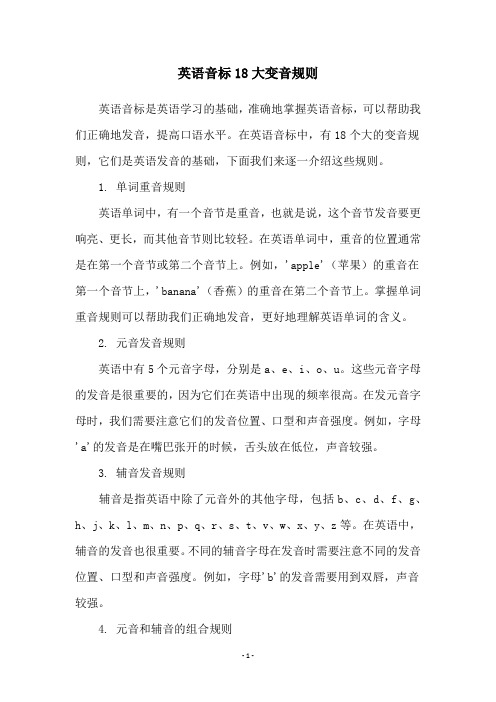
英语音标18大变音规则英语音标是英语学习的基础,准确地掌握英语音标,可以帮助我们正确地发音,提高口语水平。
在英语音标中,有18个大的变音规则,它们是英语发音的基础,下面我们来逐一介绍这些规则。
1. 单词重音规则英语单词中,有一个音节是重音,也就是说,这个音节发音要更响亮、更长,而其他音节则比较轻。
在英语单词中,重音的位置通常是在第一个音节或第二个音节上。
例如,'apple'(苹果)的重音在第一个音节上,'banana'(香蕉)的重音在第二个音节上。
掌握单词重音规则可以帮助我们正确地发音,更好地理解英语单词的含义。
2. 元音发音规则英语中有5个元音字母,分别是a、e、i、o、u。
这些元音字母的发音是很重要的,因为它们在英语中出现的频率很高。
在发元音字母时,我们需要注意它们的发音位置、口型和声音强度。
例如,字母'a'的发音是在嘴巴张开的时候,舌头放在低位,声音较强。
3. 辅音发音规则辅音是指英语中除了元音外的其他字母,包括b、c、d、f、g、h、j、k、l、m、n、p、q、r、s、t、v、w、x、y、z等。
在英语中,辅音的发音也很重要。
不同的辅音字母在发音时需要注意不同的发音位置、口型和声音强度。
例如,字母'b'的发音需要用到双唇,声音较强。
4. 元音和辅音的组合规则在英语中,元音和辅音的组合也有一些规则。
例如,当元音字母后面跟着辅音字母时,通常会发生辅音变音的现象。
这种变音被称为闭合音节变音。
例如,单词'cat'(猫)中的'a'在发音时要比单词'car'(汽车)中的'a'更封闭。
5. 元音的连读规则在英语中,当两个元音字母相邻时,它们通常会连读。
例如,单词'boat'(船)中的'o'和'a'连读,发音为/ou/。
掌握元音连读规则可以帮助我们更自然地发音,提高口语流利度。
英语中的一些变音现象及读音规则
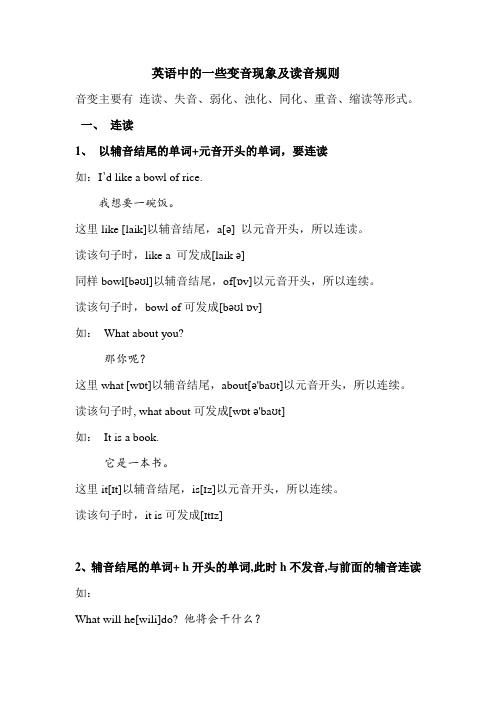
英语中的一些变音现象及读音规则音变主要有连读、失音、弱化、浊化、同化、重音、缩读等形式。
一、连读1、以辅音结尾的单词+元音开头的单词,要连读如:I’d like a bowl of rice.我想要一碗饭。
这里like [laik]以辅音结尾,a[ə] 以元音开头,所以连读。
读该句子时,like a 可发成[laik ə]同样bowl[bəʊl]以辅音结尾,of[ɒv]以元音开头,所以连续。
读该句子时,bowl of可发成[bəʊl ɒv]如:What about you?那你呢?这里what[wɒt]以辅音结尾,about[ə'baʊt]以元音开头,所以连续。
读该句子时, what about可发成[wɒt ə'baʊt]如:It is a book.它是一本书。
这里it[ɪt]以辅音结尾,is[ɪz]以元音开头,所以连续。
读该句子时,it is可发成[ɪtɪz]2、辅音结尾的单词+ h开头的单词,此时h不发音,与前面的辅音连读如:What will he[wili]do? 他将会干什么?Has he [hæzi]done it before?他之前做过这个吗?Must he [mʌsti] go?他一定要走吗?Can he [kæni] do it?他可以做吗?Should he[ʃədi]….?他应该…?Tell him to ask her[ɑːskɜː]….告诉他去叫她Leave him[liːvim].离开他For him [fɔ: im].对他而言3、“辅音+半元音”型连读英语语音中的/j/和/w/是半元音,如果前一个词是以辅音结尾,后一个词是以半元音,特别是/j/开头,此时也要连读。
如:Thank [θæŋk] you[juː] ,可读成[θæŋk juː].have [hæv]you[juː] ,可读成[hæv ju:]4、“r/re+元音”型连读如果前一个词是以-r或者-re结尾,后一个词是以元音开头,这时的r 或re不但要发/r/,而且还要与后面的元音拼起来连读。
英语的25个音变规则
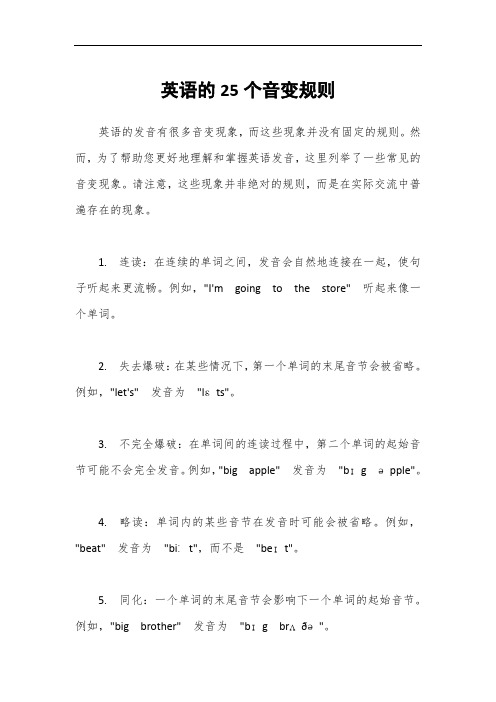
英语的25个音变规则英语的发音有很多音变现象,而这些现象并没有固定的规则。
然而,为了帮助您更好地理解和掌握英语发音,这里列举了一些常见的音变现象。
请注意,这些现象并非绝对的规则,而是在实际交流中普遍存在的现象。
1. 连读:在连续的单词之间,发音会自然地连接在一起,使句子听起来更流畅。
例如,"I'm going to the store" 听起来像一个单词。
2. 失去爆破:在某些情况下,第一个单词的末尾音节会被省略。
例如,"let's" 发音为"lɛts"。
3. 不完全爆破:在单词间的连读过程中,第二个单词的起始音节可能不会完全发音。
例如,"big apple" 发音为"bɪg əpple"。
4. 略读:单词内的某些音节在发音时可能会被省略。
例如,"beat" 发音为"biːt",而不是"beɪt"。
5. 同化:一个单词的末尾音节会影响下一个单词的起始音节。
例如,"big brother" 发音为"bɪg brʌðə"。
6. 弱读:在某些情况下,单词中的某些音节在发音时会变得较弱。
例如,"of" 在"a lot of" 中发音为"əv"。
7. 浊化:在某些情况下,清辅音在浊化环境下会变成浊辅音。
例如,"dog" 发音为"dɔg"。
8. 异化:单词的发音可能会受到周围单词的影响而发生变化。
例如,"fish" 在"fish and chips" 中发音为"fɪʃ"。
9. 音位替换:在某些情况下,单词中的一个音位会被另一个音位替换。
英语音标18大变音规则
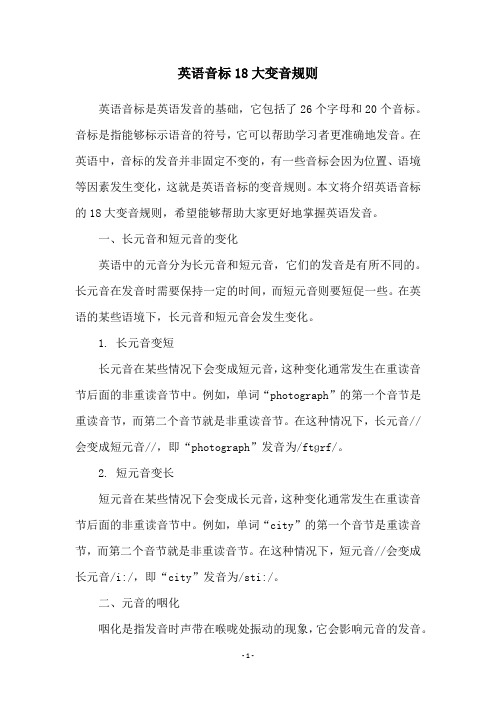
英语音标18大变音规则英语音标是英语发音的基础,它包括了26个字母和20个音标。
音标是指能够标示语音的符号,它可以帮助学习者更准确地发音。
在英语中,音标的发音并非固定不变的,有一些音标会因为位置、语境等因素发生变化,这就是英语音标的变音规则。
本文将介绍英语音标的18大变音规则,希望能够帮助大家更好地掌握英语发音。
一、长元音和短元音的变化英语中的元音分为长元音和短元音,它们的发音是有所不同的。
长元音在发音时需要保持一定的时间,而短元音则要短促一些。
在英语的某些语境下,长元音和短元音会发生变化。
1. 长元音变短长元音在某些情况下会变成短元音,这种变化通常发生在重读音节后面的非重读音节中。
例如,单词“photograph”的第一个音节是重读音节,而第二个音节就是非重读音节。
在这种情况下,长元音//会变成短元音//,即“photograph”发音为/ftɡrf/。
2. 短元音变长短元音在某些情况下会变成长元音,这种变化通常发生在重读音节后面的非重读音节中。
例如,单词“city”的第一个音节是重读音节,而第二个音节就是非重读音节。
在这种情况下,短元音//会变成长元音/i:/,即“city”发音为/sti:/。
二、元音的咽化咽化是指发音时声带在喉咙处振动的现象,它会影响元音的发音。
在英语中,有一些元音在发音时会发生咽化现象,这种变化通常发生在元音后面的/r/音。
例如,单词“car”的元音/a:/在发音时会咽化,即“car”发音为/kɑ:/。
三、元音的鼻化鼻化是指发音时气流从鼻腔流出的现象,它会影响元音的发音。
在英语中,有一些元音在发音时会发生鼻化现象,这种变化通常发生在元音后面的/n/或/m/音。
例如,单词“man”的元音//在发音时会鼻化,即“man”发音为/mn/。
四、辅音的浊化和清音化英语中的辅音分为浊音和清音,浊音在发音时需要发出声音,而清音则不需要。
在英语中,有一些辅音在发音时会发生浊化或清音化的变化。
英语变音规则
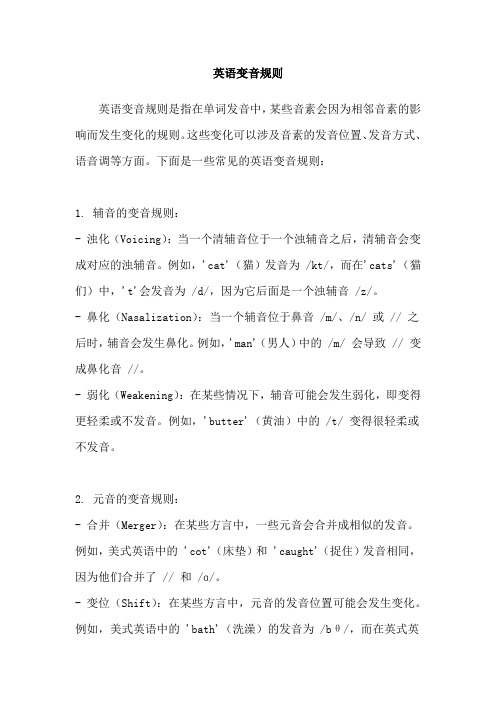
英语变音规则英语变音规则是指在单词发音中,某些音素会因为相邻音素的影响而发生变化的规则。
这些变化可以涉及音素的发音位置、发音方式、语音调等方面。
下面是一些常见的英语变音规则:1. 辅音的变音规则:- 浊化(Voicing):当一个清辅音位于一个浊辅音之后,清辅音会变成对应的浊辅音。
例如,'cat'(猫)发音为 /kt/,而在'cats'(猫们)中,'t'会发音为 /d/,因为它后面是一个浊辅音 /z/。
- 鼻化(Nasalization):当一个辅音位于鼻音 /m/、/n/ 或 // 之后时,辅音会发生鼻化。
例如,'man'(男人)中的 /m/ 会导致 // 变成鼻化音 //。
- 弱化(Weakening):在某些情况下,辅音可能会发生弱化,即变得更轻柔或不发音。
例如,'butter'(黄油)中的 /t/ 变得很轻柔或不发音。
2. 元音的变音规则:- 合并(Merger):在某些方言中,一些元音会合并成相似的发音。
例如,美式英语中的 'cot'(床垫)和 'caught'(捉住)发音相同,因为他们合并了 // 和 /ɑ/。
- 变位(Shift):在某些方言中,元音的发音位置可能会发生变化。
例如,美式英语中的 'bath'(洗澡)的发音为 /bθ/,而在英式英语中则为 /bɑθ/。
- 弱化(Weakening):在某些情况下,元音可能会发生弱化,即发音变得更短暂或不发音。
例如,'butter'(黄油)中的 // 变得更短暂。
- 升调(Raising):在某些条件下,元音的语音调可能会上升。
例如,美式英语中的 'pin'(别针)的发音为 /pn/,而在一些方言中,它的发音可能为 /pn/,语音调上升。
这些变音规则在英语中非常常见,不仅会影响单词的发音,也会对口语交流中的流利度产生影响。
在线英语培训:如何解决说英语的变音现象

青少英语:如何解决说英语的变音现象对于英语学习来说,语音基础是重要的一环,但现在国人发音堪忧,除去对英语学习的兴趣之外,很多都是因为早期发音教育尤其是音标方面的教学不足所导致,而音标难和发音不准同时也使得拼读单词困难重重。
中式英语中,经常会出现音变的现象。
你有没有经常感觉到自己说英语别人听不懂,很可能是因为自己误解了某个音标,下面立刻说likeshuo小编就来帮你总结一下音变的四种情况。
音变现象包含连读、失去爆破、加音和浊化、变音现象等。
1。
连读(辅+元): 当前一个单词以辅音结尾,后一个单词以元音开头,通常在口语,特别是在快速口语中,它们要连起来读。
发音时,前后拼起来。
就像中国的汉语拼音一样。
What’s the real situation? Let’s check it out! 真实情况是什么样的?让我们一起来查一下看Good afternoon,ladies and gentlemen !2。
失去爆破(辅+辅): 当前一个单词以辅音p,b,t,d,k,g结尾,后一个单词又以辅音开头,通常在口语,特别是在快速口语中,它们要连起来读。
发音时,前一个辅音保留发音的时候,但不发出来,而后一个辅音则要重读出来。
Let me know what you need I don’t know what you say, you ask me to sit down?3。
加音(元+元) 当前一个单词以元音结尾,后一个单词又以元音开头,通常在口语,特别是在快速口语中,它们要连起来读。
发音时,如果前一个元音以/u/,/au/或/ou /结尾,则要在两个元音间加入半元音w;如果前一个元音以/i/,/ai/,/oi/结尾,则要在两元音间加入半元音/j/,但不发出来,而后一个辅音则要重读出来。
例句:What a coincidence, we meet each other again in the same place!(/w/) Don’t stop, go on please!(/w/) How are you ? I’m going to quit my job !4。
英语变音知识点归纳总结

英语变音知识点归纳总结在英语中,变音(Vowel Reduction)是一个重要的现象,指的是当元音发音归属于无声音素(Unstressed Syllable)时,其发音会发生变化,变为中性元音或者甚至更短的元音,而不再保持其原有的清晰发音。
变音的现象在英语中非常常见,在日常交流中也十分普遍。
以下是变音知识点的归纳总结:一、无声音节和有声音节在英语中,音节可以分为无声音节和有声音节。
无声音节是指不带强调的音节,也就是没有重读音节的音节,而有声音节则是带有强调的音节,通常为句子的重要部分或者为单词的重读部分。
无声音节和有声音节在变音中会有不同的发音规则。
二、变音的类型1. 全元音(Full Vowel):当元音发音归属于有声音节时,其发音保持原有的清晰发音,不会发生变音。
2. 中性元音(Neutral Vowel):当元音发音归属于无声音节时,其发音会变为中性元音,通常是短暂的、不太明显的元音。
3. 省略元音(Schwa):有时元音发音归属于无声音节时,其发音甚至会被省略掉,不再保持圆润的音色。
三、变音的规律1. 变音的原则:无声音节中的元音发音会因为没有重音而发生变化。
2. 变音的频率:在英语中,变音是一个很普遍的现象,几乎所有的元音都会在无声音节中发生变音。
3. 变音的趋向:在一些情况下,元音在无声音节中的变音会有一定的趋向性,可以根据变音规律进行总结和归纳。
四、变音的影响1. 变音对语速的影响:变音的发生可以让发音更加自然和流畅,有助于提高语速和促进交流。
2. 变音对听力的挑战:对于非母语者来说,变音会对听力造成一定的挑战,需要通过大量的听力训练来适应和理解变音现象。
3. 变音对口语的影响:对于学习者来说,掌握变音现象是提高口语水平的关键,可以让发音更加地道和自然。
五、变音的实例1. cat(重读音节):/kæt/,元音发音是清晰的。
2. nAme(无声音节):/nəm/,元音发音变为中性元音。
英语变音规则范文
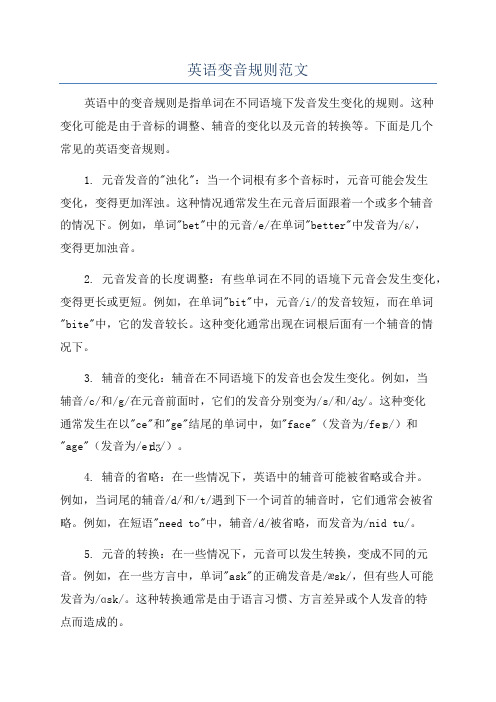
英语变音规则范文英语中的变音规则是指单词在不同语境下发音发生变化的规则。
这种变化可能是由于音标的调整、辅音的变化以及元音的转换等。
下面是几个常见的英语变音规则。
1. 元音发音的"浊化":当一个词根有多个音标时,元音可能会发生变化,变得更加浑浊。
这种情况通常发生在元音后面跟着一个或多个辅音的情况下。
例如,单词"bet"中的元音/e/在单词"better"中发音为/ɛ/,变得更加浊音。
2. 元音发音的长度调整:有些单词在不同的语境下元音会发生变化,变得更长或更短。
例如,在单词"bit"中,元音/i/的发音较短,而在单词"bite"中,它的发音较长。
这种变化通常出现在词根后面有一个辅音的情况下。
3. 辅音的变化:辅音在不同语境下的发音也会发生变化。
例如,当辅音/c/和/g/在元音前面时,它们的发音分别变为/s/和/dʒ/。
这种变化通常发生在以"ce"和"ge"结尾的单词中,如"face"(发音为/feɪs/)和"age"(发音为/eɪdʒ/)。
4. 辅音的省略:在一些情况下,英语中的辅音可能被省略或合并。
例如,当词尾的辅音/d/和/t/遇到下一个词首的辅音时,它们通常会被省略。
例如,在短语"need to"中,辅音/d/被省略,而发音为/nid tu/。
5. 元音的转换:在一些情况下,元音可以发生转换,变成不同的元音。
例如,在一些方言中,单词"ask"的正确发音是/æsk/,但有些人可能发音为/ɑsk/。
这种转换通常是由于语言习惯、方言差异或个人发音的特点而造成的。
这些变音规则是英语中常见的几种,也是在学习和理解英语发音时需要注意的地方。
通过了解这些规则,我们可以更准确地发音,并更好地理解英语中的语音变化。
英语变音音节的用法
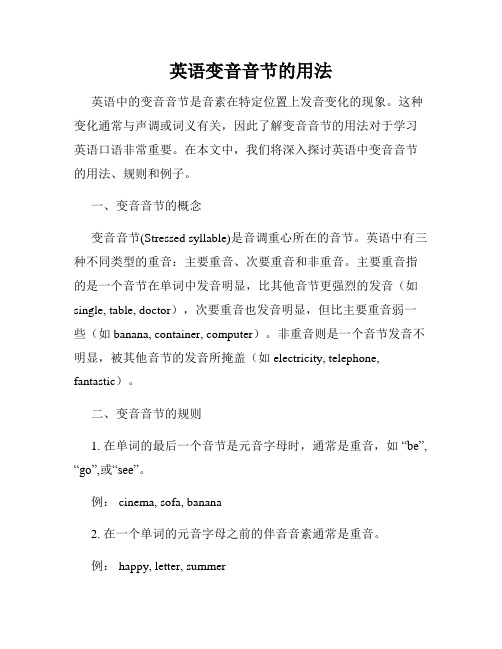
英语变音音节的用法英语中的变音音节是音素在特定位置上发音变化的现象。
这种变化通常与声调或词义有关,因此了解变音音节的用法对于学习英语口语非常重要。
在本文中,我们将深入探讨英语中变音音节的用法、规则和例子。
一、变音音节的概念变音音节(Stressed syllable)是音调重心所在的音节。
英语中有三种不同类型的重音:主要重音、次要重音和非重音。
主要重音指的是一个音节在单词中发音明显,比其他音节更强烈的发音(如single, table, doctor),次要重音也发音明显,但比主要重音弱一些(如 banana, container, computer)。
非重音则是一个音节发音不明显,被其他音节的发音所掩盖(如 electricity, telephone, fantastic)。
二、变音音节的规则1. 在单词的最后一个音节是元音字母时,通常是重音,如“be”, “go”,或“see”。
例: cinema, sofa, banana2. 在一个单词的元音字母之前的伴音音素通常是重音。
例: happy, letter, summer3. 当一个单词的最后一个音节是辅音字母时,通常不是重音。
例: credit, profit, rabbit4. 双元音在第一个成分上强调,如“coin”,“soup”,单一元音通常是中性重音。
例: boy, cloud, toy5. 如果一个单词有两个或两个以上的音节,发重音的位置通常是倒数第二个音节,除非最后一个音节是重音。
例: potato, forget, Virginia三、例句解析1. cinema –元音在单词末尾,最后一个字母a应该是发音最重的音节。
2. happy –在字母e之前的音节因为有辅音h,所以强调发音。
3. rabbit –最后一个音节是辅音t所以这个音节不是重音。
4. forget –第三音节是元音字母,因此第二个音节是重音。
5. Virginia –倒数第二音节,gi是一个大写字母代表德语发音。
单词变音

单词变音变音也叫语流音变(sound changing in connected speech)。
人们在说话时,语音不是一个一个地发出,而是连续发出的。
在连续的语流中,一个音由于受邻近的音的影响,或由于自己在语流中所处的位置不同,或说话的快慢、高低、轻重不同,就会发生语流音变。
语速有可能加快,语速一快,必然导致连读和含混音的增多。
现将常见的变音情形介绍如下:一、连读在意义和语法上相关联的两词之间,前一词的末尾音与后一词的开头音因快读而引起的词与词之间的平滑过渡叫连读。
连读时,前一个音不必充分发出来,一旦发出应立刻滑向后面的元音,使前后两个音自然结合。
可以连读的地方一般用符号“︶”来表示。
常见的可以连读的情形有:1、前一个词以辅音结尾,后一个词以元音开头。
如:I’d li(ke a)nother bow(l o)f rice. 这里like / laik / 以辅音结尾,another 以元音开头,所以连读。
例如:in an hour, first of all,to get the hang of[’hANg [v] something2、前一个词以r 或re结尾,后一个词以元音开头。
例如:There is [ ’T“[r iz] apair of[’p“[r [v] glasses here.但是,如果r或re结尾的单词当中末尾那个音节中的元音之前已有辅音[r],那么,词尾的r或re就不再发[r]音,也就是说,这个词不能和后面的词连读,象in the rear of中的rear就仍应读原来的音。
3、以辅音结尾的单词+ h开头的单词h不发音,与前面的辅音what wil(l he) [wili]do?Ha(s he) done it before?Mus(t he) [ti] go?Can he do it?Should he….?Tell him to ask her….Lea(ve him) [vim].For him (连读这个词,会发现和forum 很相似)4、两个元音相连时,有时也可连读。
音标发音要领及变音

/ 长元音。
双唇收得小而圆,并向前突出,舌后缩,舌后部抬起。
/ 短元音。
嘴巴比发 是更大点,其他一样。
单词如:/ :/ door /d saw /♦/ dog/d ♑ box /♌♦轻辅音【p 】双唇紧闭,然后快速张开,让气流冲出口腔,发出爆破音,但声带不需要震动. 浊辅音【 b 】和【p 】的发音相似,但声带需要震动.轻辅音【 t 】舌尖抵上齿龈,憋住气,然后弹开舌尖,让气流从口腔中喷出,但声带不震动.浊辅音【 d 】和【 t 】的发音相似,但声带需要震动.轻辅音【 k 】舌后部抵住软颚,憋住气,然后突然离开,将气送出来,像咳嗽一样,声带不震动. 浊辅音【 g 】和【 k 】的发音相似,但声带需要震动.发音部位首先掌握:1,上唇2,下唇3,上齿4,下齿5,上齿龈6,下齿龈7硬颚8软颚9,舌尖10,舌前11,舌中12,舌后13,声带14,气管15,鼻腔(2)发音时候要注意轻辅音和浊辅音的区别不是在于口形,主要是在于喉咙那里!当你发音时应该有震动的就是浊辅音,没有震动的就是轻辅音,所以你在练习的时候要注意的就是用手摸着自己的喉咙去练习,这样就可以事半功倍了!(3)怎么让声带震动呢?首先你要了解胸腔和腹腔发出的声音是不相同的,腹腔发音比较饱满,声带也会震动,而胸腔发音比较短促,所以不带震动!注:1、中国人发音的最大难点之一——舌边音[l]舌边音[ l ]也叫做舌侧音,国人学英语最有问题之一。
它一般出现在单词前面、中间和后面。
英语[ l ]音分为两种:清晰[ l ]和模糊[ l ]。
清晰舌边音出现元音之前,模糊舌边音出现元音之后,一般在词的末尾或辅音之前.中国学生最容易忽略、也最容易读错的就是元音之后的模糊舌边音,部分人会把这个音省略掉或者把它读成汉语“儿”字,变成卷舌音。
如well读成wear,bill读成“比尔”。
要发音漂亮,就一定要彻底攻克舌边音。
模糊舌边音音秘诀:舌尖抬起,抵住上齿龈根部,舌面凹,舌后部微微抬,气流舌面形成凹形产生共鸣,音要响亮.简单点说,就每次看到单词后面有 l 时,就一定要记得把舌尖贴住上齿龈根部,去马上找个镜子来看一看。
英语音标18大变音规则
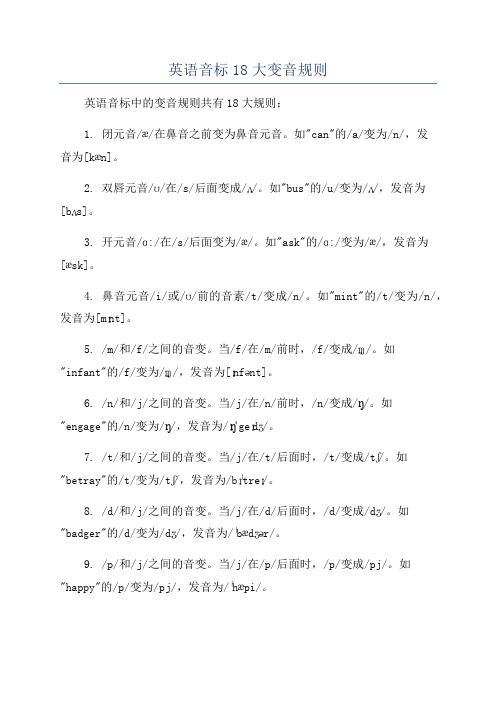
英语音标18大变音规则英语音标中的变音规则共有18大规则:1. 闭元音/æ/在鼻音之前变为鼻音元音。
如"can"的/a/变为/n/,发音为[kæn]。
2. 双唇元音/ʊ/在/s/后面变成/ʌ/。
如"bus"的/u/变为/ʌ/,发音为[bʌs]。
3. 开元音/ɑ:/在/s/后面变为/æ/。
如"ask"的/ɑ:/变为/æ/,发音为[æsk]。
4. 鼻音元音/i/或/ʊ/前的音素/t/变成/n/。
如"mint"的/t/变为/n/,发音为[mɪnt]。
5. /m/和/f/之间的音变。
当/f/在/m/前时,/f/变成/ɱ/。
如"infant"的/f/变为/ɱ/,发音为[ɪnfənt]。
6. /n/和/j/之间的音变。
当/j/在/n/前时,/n/变成/ŋ/。
如"engage"的/n/变为/ŋ/,发音为/ɪŋˈgeɪdʒ/。
7. /t/和/j/之间的音变。
当/j/在/t/后面时,/t/变成/tʃ/。
如"betray"的/t/变为/tʃ/,发音为/bɪˈtreɪ/。
8. /d/和/j/之间的音变。
当/j/在/d/后面时,/d/变成/dʒ/。
如"badger"的/d/变为/dʒ/,发音为/ˈbædʒər/。
9. /p/和/j/之间的音变。
当/j/在/p/后面时,/p/变成/pj/。
如"happy"的/p/变为/pj/,发音为/ˈhæpi/。
10. /g/和/j/之间的音变。
当/j/在/g/后面时,/g/变成/dʒ/。
如"digest"的/g/变为/dʒ/,发音为/daɪˈdʒest/。
11. /k/和/j/之间的音变。
当/j/在/k/后面时,/k/变成/tʃ/。
英语中的变音现象

1 Consonant / Vowel2 Consonant / Consonant3 Vowel / Vowel4 T, D, S, or Z + Y1、以辅音结尾的单词+元音开头的单词:要连读如: Your eyes 1a(one a) a bowl of rice. My name isLA (Los Angeles) [e lei]902-5050 [nai nou tu: fai vou fai vou]注意:以辅音结尾指的是音标中的最后一个音是辅音,而不是单词的结尾,这如同u[ju:.]niversity前面的定冠词必须用a 一样。
另:以辅音结尾的单词 + h开头的单词h不发音,人称代词:he、him、her、his与前面的辅音连读。
Did he? Does he? Was he? Has he? Is he? Will he? Would he? Can he?Wouldn't you?(wooden chew?)Shouldn't I?(shudn nai)Won't he? (won knee?)Didn't he?(didn knee?)Hasn't he?(haz a knee?)Wouldn't he?(wooden knee?)Isn't he?(is a knee?)Isn't it? (is a nit?)Doesn't it?(duza nit?)Aren't I?(are nai?)Won't you?(won chew?)Don't you?(don chew?)Can't you?(can chew?)Could you?(ku dʒ u:?)Would you?(wu d3ju?)Tell him to ask her….Leave him For himGive her a book. Giv-er a book.Tell him to ask her. Tell-im to ask-er.What will he do? What will-i do?Where will he go? Where will-i go?When will he come? When will-i come?who will he meet? who will-i meet?How will he know? How will-i know?Has he gone? Has-i gone?Had he done it before? Had-i done it before?Must he go? Must-i go?Can he do it? Can-i do it?Should he leave? Should-i leave?2、辅音+辅音的连读如果前面的单词结尾的清辅音,后面单词开头是与之相对应的浊辅音,或者相反,只发后面的辅音t-d tʃ-dʒ s-z ʃ -ʒ p-b f-v k-gsi t down I don’t know(发音再次的老师都不会发出 [t] 音)I jus t didn't ge t the chance.Bi g cake Da d tol d me Hu ge change Goo d night3、元音+元音当前面的单词以元音结尾,后面的单词以元音开头,两个元音连读,连读的方法是在中间加w或者加j.以ou结尾的元音后面一般加w。
英语中的变音现象资料

英语中的变音现象我们都有过这样沮丧的经验,很容易听懂中国人说的英语,但是同样的对话一到英美人的嘴里,便觉得很难跟上,有时甚至是不知所云。
这主要是因为我们说的英语通常单词一个一个的发,每个都很清晰,词与词之间有明显的pause, 但是英美人的口语会有很多音变,这些音变使得我们很熟悉的单词的发音变得陌生,难懂,给我们的听力造成了很大的困难,因此了解并使用各音变规则会帮助我们提高听力,使我们的发音更加地道。
音变主要有连读、失音、弱化、浊化、同化、重音、缩读等形式。
言归正题, 以下列出给听力造成很大障碍的五种音变现象及其读音规则,以及最后一项关于英语的节奏,希望能有所帮助!一、连读连读有四种类型:1 Consonant / Vowel2 Consonant / Consonant3 Vowel / Vowel4 T, D, S, or Z + Y1、以辅音结尾的单词+元音开头的单词:要连读如: Your eyes 1a(one a) a bowl of rice. My name isLA (Los Angeles) [e lei]902-5050 [nai nou tu: fai vou fai vou]注意:以辅音结尾指的是音标中的最后一个音是辅音,而不是单词的结尾,这如同u[ju:.]niversity前面的定冠词必须用a 一样。
另:以辅音结尾的单词 + h开头的单词h不发音,人称代词:he、him、her、his与前面的辅音连读。
Did he? Does he? Was he? Has he? Is he? Willhe? Would he? Can he?Wouldn't you?(wooden chew?)Shouldn't I?(shudn nai)Won't he? (won knee?)Didn't he?(didn knee?)Hasn't he?(haz a knee?)Wouldn't he?(wooden knee?)Isn't he?(is a knee?)Isn't it? (is a nit?)Doesn't it?(duza nit?)Aren't I?(are nai?)Won't you?(won chew?)Don't you?(don chew?)Can't you?(can chew?)Could you?(ku dʒ u:?)Would you?(wu d3ju?)Tell him to ask her….Leave him For himGive her a book. Giv-er a book. Tell him to ask her. Tell-im to ask-er. What will he do? What will-i do? Where will he go? Where will-i go? When will he come? When will-i come? who will he meet? who will-i meet? How will he know? How will-i know? Has he gone? Has-i gone? Had he done it before? Had-i done it before?Must he go? Must-i go?Can he do it? Can-i do it?Should he leave? Should-i leave?2、辅音+辅音的连读如果前面的单词结尾的清辅音,后面单词开头是与之相对应的浊辅音,或者相反,只发后面的辅音t-d tʃ-dʒ s-z ʃ -ʒ p-b f-v k-gsi t down I don’t know(发音再次的老师都不会发出 [t] 音)I jus t didn't ge t the chance.Bi g cake Da d tol d me Hu ge change Goo d night3、元音+元音当前面的单词以元音结尾,后面的单词以元音开头,两个元音连读,连读的方法是在中间加w或者加j.以ou结尾的元音后面一般加w。
英语中的一些变音现象及读音规则
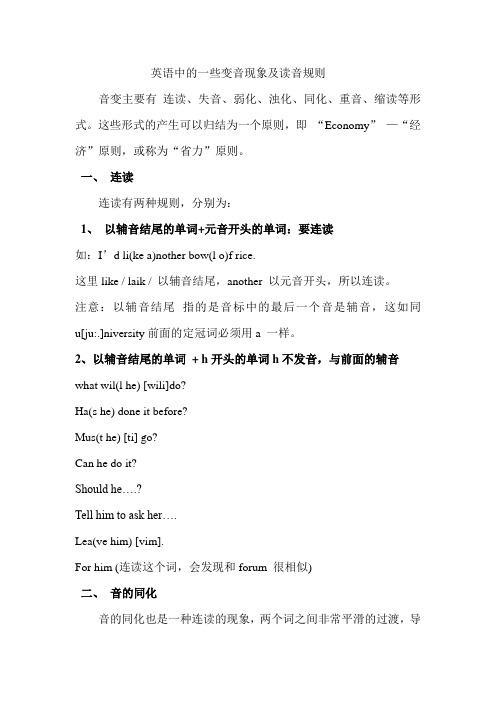
英语中的一些变音现象及读音规则音变主要有连读、失音、弱化、浊化、同化、重音、缩读等形式。
这些形式的产生可以归结为一个原则,即“Economy”—“经济”原则,或称为“省力”原则。
一、连读连读有两种规则,分别为:1、以辅音结尾的单词+元音开头的单词:要连读如:I’d li(ke a)nother bow(l o)f rice.这里like / laik / 以辅音结尾,another 以元音开头,所以连读。
注意:以辅音结尾指的是音标中的最后一个音是辅音,这如同u[ju:.]niversity前面的定冠词必须用a 一样。
2、以辅音结尾的单词+ h开头的单词h不发音,与前面的辅音what wil(l he) [wili]do?Ha(s he) done it before?Mus(t he) [ti] go?Can he do it?Should he….?Tell him to ask her….Lea(ve him) [vim].For him (连读这个词,会发现和forum 很相似)二、音的同化音的同化也是一种连读的现象,两个词之间非常平滑的过渡,导致一个音受临音影响而变化。
主要是以下三种方式:1、辅音[d]与[j]相邻时,被同化为[dэ]:Would you....?2、辅音[t]与[j]相邻时,被同化为[t∫]:Can’t you:。
?3、辅音[s]与[j]相邻时, 被同化为[∫]:Miss you三、失音由于失去爆破是失音的一种现象,摩擦音也会被失去,所以统称为失音。
注意:爆破音并不是完全失去,仍然形成阻碍,把气流堵在里面,但不爆破,直接发出相邻的辅音。
规则:1、辅音爆破音或摩擦音后面跟的是爆破音、破擦音和摩擦等,前面的辅音要失去爆破。
这样的例子有很多很多:Sit down: 发音再次的老师都不会发出[t] 音Contact lens:Big cakeDad told meHuge changeGood night四、浊化1、[S] 后面的清辅音要浊化Discussion:[k] 浊化成[g]Stand:[t] 浊化成[d]Expression:[p]浊化成2、美音中:[t] 在单词的中间被浊化成[d] 如:writer,听起来和rider 的发音几乎没有区别letter—ladder。
英语中的变音现象
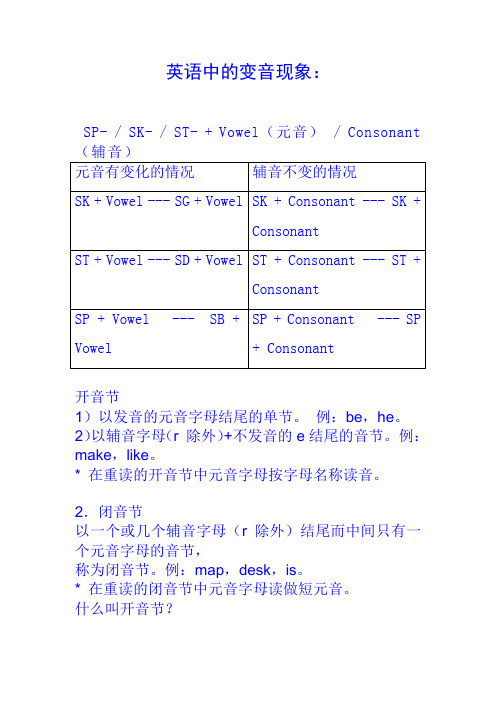
英语中的变音现象:
SP- / SK- / ST- + Vowel(元音) / Consonant (辅音)
开音节
1)以发音的元音字母结尾的单节。
例:be,he。
2)以辅音字母(r 除外)+不发音的e结尾的音节。
例:make,like。
* 在重读的开音节中元音字母按字母名称读音。
2.闭音节
以一个或几个辅音字母(r 除外)结尾而中间只有一个元音字母的音节,
称为闭音节。
例:map,desk,is。
* 在重读的闭音节中元音字母读做短元音。
什么叫开音节?
开音节分两种,一种叫绝对开音节,相对开音节。
①绝对开音节:单个元音字母后面没有辅字组的重读音节。
例如:no blue ba-by stu-dent se-cret.
②相对开音节:单个元音字母后面加单个辅音字母,再加一个不发音字母e构成的重读音节。
例如:name these bike home ex-cuse.
什么叫闭音节?
单个元音字母后面有辅字组(r除外)且以辅字组结尾的重读音节。
例如:bag egg fish not cup。
英语元音变音
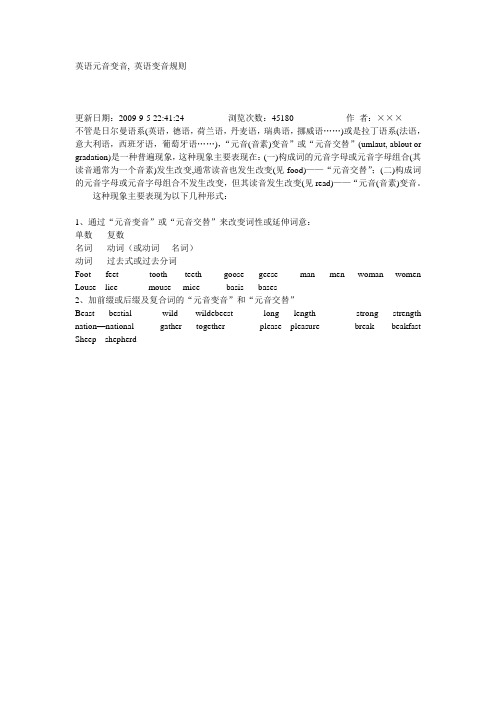
英语元音变音, 英语变音规则
更新日期:2009-9-5 22:41:24浏览次数:45180作者:×××
不管是日尔曼语系(英语,德语,荷兰语,丹麦语,瑞典语,挪威语……)或是拉丁语系(法语,意大利语,西班牙语,葡萄牙语……),“元音(音素)变音”或“元音交替”(umlaut, ablout or gradation)是一种普遍现象,这种现象主要表现在:(一)构成词的元音字母或元音字母组合(其读音通常为一个音素)发生改变,通常读音也发生改变(见food)——“元音交替”;(二)构成词的元音字母或元音字母组合不发生改变,但其读音发生改变(见read)——“元音(音素)变音。
这种现象主要表现为以下几种形式:
1、通过“元音变音”或“元音交替”来改变词性或延伸词意:
单数-----复数
名词-----动词(或动词----名词)
动词-----过去式或过去分词
Foot-----feet tooth------teeth goose-----geese man-----men woman----women Louse---lice mouse----mice basis-----bases
2、加前缀或后缀及复合词的“元音变音”和“元音交替”
Beast-----bestial wild------wildebeest long-----length strong-----strength nation—national gather-----together please---pleasure break------beakfast Sheep---shepherd。
英语听力中的变音

英语听力中的变音在平时的高考听力训练中,我们可能会发现所听到的一些词在短语或句子中的读音与单词在课本或词典中的注音不一样,这就是我们要说的变音。
变音也叫语流音变(sound changing in connected speech)。
人们在说话时,语音不是一个一个地发出,而是连续发出的。
在连续的语流中,一个音由于受邻近的音的影响,或由于自己在语流中所处的位置不同,或说话的快慢、高低、轻重不同,就会发生语流音变。
今年听力语速有可能加快,语速一快,必然导致连读和含混音的增多。
为了使同学们能适应这些变化,现将常见的变音情形介绍如下:一、连读在意义和语法上相关联的两词之间,前一词的末尾音与后一词的开头音因快读而引起的词与词之间的平滑过渡叫连读。
连读时,前一个音不必充分发出来,一旦发出应立刻滑向后面的元音,使前后两个音自然结合。
可以连读的地方一般用符号"︶"来表示。
常见的可以连读的情形有:1、前一个词以辅音结尾,后一个词以元音开头。
例如:in an hour, first of all,︶︶︶︶to get the hang of['hANg [v] something︶2、前一个词以r 或re结尾,后一个词以元音开头。
例如:There is [ 'T"[r iz] a︶pair of['p"[r [v] glasses here.︶但是,如果r或re结尾的单词当中末尾那个音节中的元音之前已有辅音[r],那么,词尾的r 或re就不再发[r]音,也就是说,这个词不能和后面的词连读,象in the rear of中的rear就仍应读原来的音。
3、两个元音相连时,有时也可连读。
元音连读时根据前一个单词词尾所发的音,又可分为以下三种情况:①前面的单词以[u]、[u:]、[[u]、[au]等元音结尾时,可以加入一个半元音[w]进行连读。
例如:Do it['du:w it] again./How old['hauw '[uld] are you?/how and['hauw [nd] why/Let's go over['g[uw '[uv[] the exercises.②前面的单词以[i]、[i:]、[ei]、[ai]、[Ci]等元音结尾时,可以加入一个半元音[j]进行连读。
英语变音规则范文

英语变音规则范文英语语音变音规则是指在一些特定的语音环境下,音素的发音会发生改变,即变音。
英语变音规则比较复杂,可以从以下几个方面进行分类和描述:1.辅音的变音规则:a) 清浊音的变音:清辅音变浊音,例如/p/变成/b/、/t/变成/d/、/k/变成/g/等。
这种变音规则主要出现在动词的词尾(如: "jumped"[dʒʌmpt]),以及复数形式(如: "cats" [kæts]),主要用于区分时态和数的意义。
b) 重读辅音的变音:在强重读音节中,一些辅音的发音会发生变化,如/t/变成/ʃ/("nation" [ˈneɪʃən])或/d/变成/ʒ/("vision" [ˈvɪʒən])等。
c) 辅音完全丢失:在一些情况下,辅音音素可以完全丢失,如词尾的/t/("first" [fɜːst])、/d/("good" [ɡʊd])等。
d)关于"r"的变音:"r"音在英语中有很多不同的变音规则,如在单词尾部、词中、词首等不同位置,根据音节的特点和发音的规律,"r"音有时发音,有时不发音。
2.元音的变音规则:a) 双元音:一些元音组合成双元音,即两个音位合并成为一个音位。
例如,/aɪ/("I")、/ɔɪ/("boy")、/eə/("air")等。
b) 弱化元音:在一些情况下,弱化元音可以出现,如名词的词尾(如: "butter" [ˈbʌtər])、动词在进行时的词尾(如: "running"[ˈrʌnɪŋ])等。
c) 长元音:一些元音的发音时间较短,称为短元音,而一些元音的发音时间较长,称为长元音。
例如/i/("beet")和/iː/("beat")的区别。
- 1、下载文档前请自行甄别文档内容的完整性,平台不提供额外的编辑、内容补充、找答案等附加服务。
- 2、"仅部分预览"的文档,不可在线预览部分如存在完整性等问题,可反馈申请退款(可完整预览的文档不适用该条件!)。
- 3、如文档侵犯您的权益,请联系客服反馈,我们会尽快为您处理(人工客服工作时间:9:00-18:30)。
我们都有过这样沮丧的经验,很容易听懂中国人说的英语,但是同样的对话一到英美人的嘴里,便觉得很难跟上,有时甚至是不知所云。
这主要是因为我们说的英语通常单词一个一个的发,每个都很清晰,词与词之间有明显的pause, 但是英美人的口语会有很多音变,这些音变使得我们很熟悉的单词的发音变得陌生,难懂,给我们的听力造成了很大的困难,因此了解并使用各音变规则会帮助我们提高听力,使我们的发音更加地道。
音变主要有连读、失音、弱化、浊化、同化、重音、缩读等形式。
言归正题, 以下列出给听力造成很大障碍的五种音变现象及其读音规则,以及最后一项关于英语的节奏,希望能有所帮助!一、连读连读有四种类型:1 Consonant / Vowel2 Consonant / Consonant3 Vowel / Vowel4 T, D, S, or Z + Y1、以辅音结尾的单词+元音开头的单词:要连读如:Your eyes 1a(one a) a bowl of rice. My name isLA (Los Angeles) [e lei]902-5050 [nai nou tu: fai vou fai vou]注意:以辅音结尾指的是音标中的最后一个音是辅音,而不是单词的结尾,这如同u[ju:.]niversity前面的定冠词必须用a 一样。
另:以辅音结尾的单词+ h开头的单词h不发音,人称代词:he、him、her、his与前面的辅音连读。
Did he Does he Was he Has he Is he Will he Would he Can heWouldn't you(wooden chew)Shouldn't I(shudn nai)Won't he (won knee)Didn't he(didn knee)Hasn't he(haz a knee)Wouldn't he(wooden knee)Isn't he(is a knee)Isn't it (is a nit)Doesn't it(duza nit)Aren't I(are nai)Won't you(won chew)Don't you(don chew)Can't you(can chew)Could you(ku dʒu:)Would you(wu d3ju)Tell him to ask her….Leave him For himGive her a book. Giv-er a book.Tell him to ask her. Tell-im to ask-er.What will he do What will-i doWhere will he go Where will-i goWhen will he come When will-i comewho will he meet who will-i meetHow will he know How will-i knowHas he gone Has-i goneHad he done it before Had-i done it beforeMust he go Must-i goCan he do it Can-i do itShould he leave Should-i leave2、辅音+辅音的连读如果前面的单词结尾的清辅音,后面单词开头是与之相对应的浊辅音,或者相反,只发后面的辅音t-d tʃ-dʒs-z ʃ-ʒp-b f-v k-gsi t down I don’t know(发音再次的老师都不会发出[t] 音)I jus t didn't ge t the chance.Bi g cake Da d tol d me Hu ge change Goo d night3、元音+元音当前面的单词以元音结尾,后面的单词以元音开头,两个元音连读,连读的方法是在中间加w或者加j.以ou结尾的元音后面一般加w。
而以长元音i:结尾的后面加jGo (w)away who (w)is so (w)honest do (w)I she (j)is但发这两个音的时候不要太强太故作。
不然的话还不如不发。
4、T, D, S, or Z + Y的连读:当一个单词是以t d s z 结尾,后面的单词是以y(j)开头的话要连读:4-1 t+y 连读成/tʃ/Wha t’s y our nameCan’t you do itI’ll le t you know.4-2 d+y连读成/ dʒu:/Did you see itHow did you like itCould you tell4-3 s+y连读ʃYes,you areBless youGuess your age4-4 z+y连读成ʒHow’s your familyWho’s your friendWhen’s your birthday呵呵!我第一次知道这一连读规则时,兴奋不已,很容易的听懂了许多以前觉得很难以理解的句子,并且按照这种连读方式发音省力、轻松了许多。
二、失音由于失去爆破是失音的一种现象,摩擦音也会被失去,所以统称为失音。
注意:爆破音并不是完全失去,仍然形成阻碍,把气流堵在里面,但不爆破,直接发出相邻的辅音。
Disappearing /T/关于/t/失音问题:The sound /t/ tends to be unstable in many words and phrases. Sometimes it's there. Sometimes it isn't. There is a process called elision which deletes /t/ when it is preceded by a voiceless consonant and followed by any consonant except /h/. Here are some examples: Christmas last week most people act sensibly software internationalDisappearing /d/we saw that /t/ can disappear in certain circumstances. The same is true of /d/, but the circumstances are slightly different. If /d/ is preceded by a voiced consonant /b d g v D z Z dZ m n N l/ and it is followed by a consonant other than /h/, then it can be deleted (elided). Here are some examples: handbag old man used toTaken together, the disappearance of /t/ and /d/ is called alveolar plosive elision.三、浊化1、[S] 后面的清辅音要浊化[k] 浊化成[g] sky Discussion:[t] 浊化成[d] Stand[p]浊化成[b] speak Expression还有[tr]—[dr] strike2、美音中t 在单词的中间被浊化成[d]如:writer,听起来和rider 的发音几乎没有区别letter—ladder out of2-1在单词的前面或后面就不浊化比如:Ted took ten tomatoes. first , coast, hot, late,fat, goat, hit, put, not, hurt,等。
2-2在过去式中ed的发音:在清辅音后面发t: laughed [la:ft], picked [pIkt], hoped [houpt], raced [reist], watched [wa: tʃt], washed [wa: ʃt]在浊辅音后面发d : halved [hævd], rigged [rigd], nabbed [næbd], raised [reizd], smoothed [smu: ðd]Exceptions: wicked [wikd], naked [nakd], crooked [kr¨1d], etcT或d后面发/id/ started founded2-3 t和n连在一起的时候,由于口位差不多,通常t就不发音了。
1. interview -innerviewinnernet–twenny–winner或winder或ender美国人和加拿大人发音为了省事,习惯清音浊化,尤其是[t]在单词的中间一定会浊化成[d],但英国人发音不会这样,这也是英音和美音的一大区别。
了解这一浊化原则,会给听力带来一些帮助。
四、弱读一般来说:实词重读,如动词、名词、副词等;虚词弱读,如介词、代词等弱读的规则一般是:元音音节弱化成[ə] 或[ʌ]比如说如下几个单词:for/to/some/does/of查字典会发现这些词都至少有两种读音,如for:重读时[fɔ:] ,弱读时[fə] to有三种读法[tu:][tə][t] some也有三种读法[sʌm][səm][sm].does也有两种读法[dʌz][dəz] of居然有四种读法[ɔv][əv][v][f],没想到啊!真是没想到啊!举几个例子:1、To的弱读:to的前面是辅音弱读成t或t ətoday/t’dei/tonight/t’nait/we have to/hæftə/ go.To的前面如果是元音,那就弱读成d或dəI go to/goudə/workat a quarter to two We plan to do it.2、for的弱读:在句中读/fər/句末读/f ɔ:r/This is for/fər/ you. It's for/fər/ my friend.What is this for/f ɔ:r/ Who did you get it for/f ɔ:r/3、and弱读成/n/bread and butter4、or弱读成/ər/Soup or/su:pər/ salad left or right5、are弱读成/ər/ What are you doing How are you6、your弱读成/jər/ How's your family Is this your car还有很多,希望多听,细心体会。
